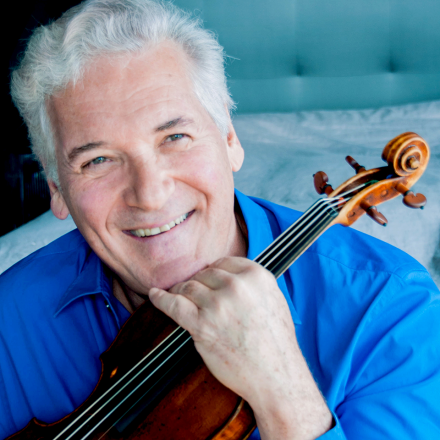Dull Bruch from Zuk, blazing Bartók from Conlon and New World at Arsht

Pinchas Zukerman performed Bruch’s Violin Concerto No. 1 with James Conlon and the New World Symphony Saturday night at the Arsht Center in Miami. Photo: Cheryl Mazak
A star soloist typically joins New World Symphony when the orchestra crosses the bay and performs at Miami’s Arsht Center.
On Saturday night the star was the violinist Pinchas Zukerman, performing Max Bruch’s much-loved, much-overplayed Violin Concerto No. 1.
Now 70, Zukerman has white hair but walks with the energetic gait of a younger man. His violin technique remains formidable, his bow arm steady, his intonation accurate. He probably scratched a bit more than he did in his prime, and fast passages occasionally came off as an inarticulate smudge. But his tone retained its rich vibrato, without a trace of the warble that creeps into the sounds of colleagues of a similar age.
But he deployed this technique on a concerto that’s performed way too often. Bruch wrote two other fine violin concertos that are almost never played in public. This timid choice of repertory, combined with a performance that often seemed emotionally detached, gave the impression that the great virtuoso was coasting.
He took the Prelude at a deliberate pace, giving a brooding quality to the heavy chords that contrasted to the speed with which he snapped off the runs. The movement leads to a climactic passage in which the violinist’s arpeggios build to an outburst in the orchestra. But as Zukerman played the arpeggios, there wasn’t much dramatic punch.
In the Adagio, his lush tone came to the fore, particularly with the rich baritone he brought to melodies on the instrument’s lower strings. And he knew how to dial it back, playing with a chaste tone in the pianissimo passages that still could be heard over the orchestra. Yet too often in this movement, he played like a man in a hurry, whiffing over many passages in a manner that gave an emotionally flat effect to a songful movement that’s at the heart of the concerto.
In the finale, his virtuoso technique rose to the challenge, as he accurately snapped off fast passages of two simultaneous notes. The orchestra, led by guest conductor James Conlon, whose titles include music director of the Los Angeles Opera, delivered in its big movements, performing with symphonic grandeur in the climactic tutti at the end of the first movement and the last movement’s sweeping second theme.
he concert opened with New World’s conducting fellow Dean Whiteside leading the orchestra in Liszt’s brief tone poem Orpheus. Less loud and aggressive than some of the composer’s better-known works, Orpheus is built around a lyric theme that appears repeatedly in various combinations of instruments.
Whiteside maintained a fine sense of balance and long-lined structure, bringing ever-greater force to the melody as it appeared in winds, strings and brass. When the theme returned in the violins in a climactic passage toward the end, he opened the orchestra up to full power, with a breadth of phrasing that maximized its impact.
The best music-making came in the second half, when Conlon led a performance of Bartók’s Concerto for Orchestra.
From its eerie opening to the frantic string passages at the end, this was a well-paced, finely calibrated performance of Bartók’s brew of classical music and eastern European folk melodies. Polished and virtually technically flawless, the performance allowed the primitive force at the heart of the concerto to push through the smooth concert-hall veneer.
Fine-grained string playing marked the mysterious passage with which the work begins, as Conlon led a crescendo with which the metronomic bass line acquired savage force. The brass section brought a shining tone to the earthy brass passages that are so characteristic of the composer.
Bassoons contributed wit and a trace of exaggeration to the melody that opens the second movement, known as the “Game of Pairs.” The brass section, which had played with rustic aggressiveness in the first movement, now brought a refined, balanced tone to its choir-like chords.
Violas brought a noble tone to the broad melody of the fourth movement. In the finale, strings played with a frenetic excitement in their high-speed passages, attacking the music in an unbridled manner that generated edgy excitement all the way to the blazing coda.
Posted in Performances
Leave a Comment
Sun Jan 13, 2019
at 10:49 am
No Comments
